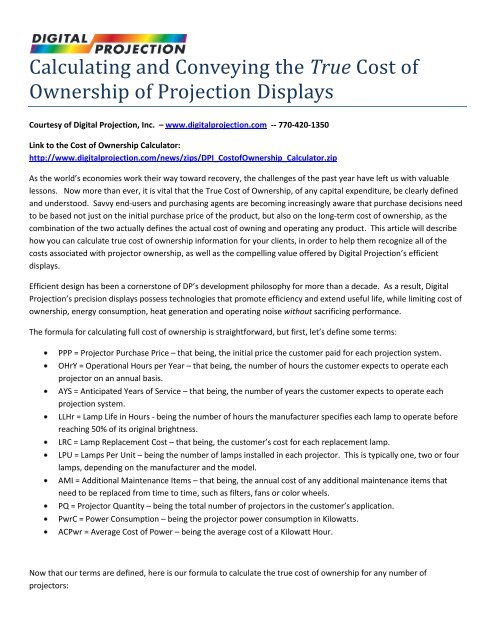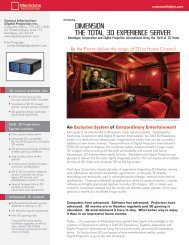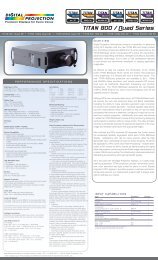Calculating True Cost of Ownership - Digital Projection
Calculating True Cost of Ownership - Digital Projection
Calculating True Cost of Ownership - Digital Projection
You also want an ePaper? Increase the reach of your titles
YUMPU automatically turns print PDFs into web optimized ePapers that Google loves.
<strong>Calculating</strong> and Conveying the <strong>True</strong> <strong>Cost</strong> <strong>of</strong><br />
<strong>Ownership</strong> <strong>of</strong> <strong>Projection</strong> Displays<br />
Courtesy <strong>of</strong> <strong>Digital</strong> <strong>Projection</strong>, Inc. – www.digitalprojection.com -- 770-420-1350<br />
Link to the <strong>Cost</strong> <strong>of</strong> <strong>Ownership</strong> Calculator:<br />
http://www.digitalprojection.com/news/zips/DPI_<strong>Cost</strong><strong>of</strong><strong>Ownership</strong>_Calculator.zip<br />
As the world’s economies work their way toward recovery, the challenges <strong>of</strong> the past year have left us with valuable<br />
lessons. Now more than ever, it is vital that the <strong>True</strong> <strong>Cost</strong> <strong>of</strong> <strong>Ownership</strong>, <strong>of</strong> any capital expenditure, be clearly defined<br />
and understood. Savvy end-users and purchasing agents are becoming increasingly aware that purchase decisions need<br />
to be based not just on the initial purchase price <strong>of</strong> the product, but also on the long-term cost <strong>of</strong> ownership, as the<br />
combination <strong>of</strong> the two actually defines the actual cost <strong>of</strong> owning and operating any product. This article will describe<br />
how you can calculate true cost <strong>of</strong> ownership information for your clients, in order to help them recognize all <strong>of</strong> the<br />
costs associated with projector ownership, as well as the compelling value <strong>of</strong>fered by <strong>Digital</strong> <strong>Projection</strong>’s efficient<br />
displays.<br />
Efficient design has been a cornerstone <strong>of</strong> DP’s development philosophy for more than a decade. As a result, <strong>Digital</strong><br />
<strong>Projection</strong>’s precision displays possess technologies that promote efficiency and extend useful life, while limiting cost <strong>of</strong><br />
ownership, energy consumption, heat generation and operating noise without sacrificing performance.<br />
The formula for calculating full cost <strong>of</strong> ownership is straightforward, but first, let’s define some terms:<br />
PPP = Projector Purchase Price – that being, the initial price the customer paid for each projection system.<br />
OHrY = Operational Hours per Year – that being, the number <strong>of</strong> hours the customer expects to operate each<br />
projector on an annual basis.<br />
AYS = Anticipated Years <strong>of</strong> Service – that being, the number <strong>of</strong> years the customer expects to operate each<br />
projection system.<br />
LLHr = Lamp Life in Hours - being the number <strong>of</strong> hours the manufacturer specifies each lamp to operate before<br />
reaching 50% <strong>of</strong> its original brightness.<br />
LRC = Lamp Replacement <strong>Cost</strong> – that being, the customer’s cost for each replacement lamp.<br />
LPU = Lamps Per Unit – being the number <strong>of</strong> lamps installed in each projector. This is typically one, two or four<br />
lamps, depending on the manufacturer and the model.<br />
AMI = Additional Maintenance Items – that being, the annual cost <strong>of</strong> any additional maintenance items that<br />
need to be replaced from time to time, such as filters, fans or color wheels.<br />
PQ = Projector Quantity – being the total number <strong>of</strong> projectors in the customer’s application.<br />
PwrC = Power Consumption – being the projector power consumption in Kilowatts.<br />
ACPwr = Average <strong>Cost</strong> <strong>of</strong> Power – being the average cost <strong>of</strong> a Kilowatt Hour.<br />
Now that our terms are defined, here is our formula to calculate the true cost <strong>of</strong> ownership for any number <strong>of</strong><br />
projectors:
<strong>True</strong> <strong>Cost</strong> <strong>of</strong> <strong>Ownership</strong> =<br />
((PPP + (((((OHrY x AYS) / LLHr) – 1) x (LRC x LPU)) + (AMI x AYS))) + (OHrY x AYS x PwrC x ACPwr)) x PQ<br />
You can download the calculator as an Excel spreadsheet by clicking here. Included in the .zip file are Excel versions <strong>of</strong><br />
the calculator for both Office 2003 and Office 2007.<br />
You can also copy and paste this formula, formatted for Excel, into a spreadsheet:<br />
+((PPP+(((((OHrY*AYS)/LLHr)-1)*(LRC*LPU))+(AMI*AYS)))+(OHrY*AYS*PwrC*CPwr))*PQ<br />
You may note that within the formula, one set <strong>of</strong> lamps is deducted from the total lamps consumed by each projector<br />
during its operational life. This accounts for the fact that the purchase price <strong>of</strong> each new projector already includes one<br />
set <strong>of</strong> lamps, which are already installed in the unit. Those are the first lamps used.<br />
Here is an example <strong>of</strong> how to put the formula to work in a real world application:<br />
We will assume a high-use application - 24 hour-per-day, 7 days-per-week, that employs (4) TITAN 1080p-700 displays,<br />
which are dual lamp projectors. Being 3-chip displays, beyond lamps and filters, no additional maintenance items are<br />
required.<br />
First, let’s organize our data:<br />
PPP = Projector Purchase cost = $67,000 (list price <strong>of</strong> a TITAN 1080p 500 and a typical lens)<br />
OHrY = Operational Hours per Year = 8760 (24 hours per day x 365 days per year)<br />
AYS = Anticipated Years <strong>of</strong> Service = 7<br />
LLHr = Lamp Life in Hours = 2000<br />
LRC = Lamp Replacement <strong>Cost</strong> =$995<br />
LPU = Lamps Per Unit = 2<br />
AMI = Additional Maintenance items = $0<br />
PQ = Projector Quantity = 4<br />
PwrC = Power Consumption= .950 Kw -= per the published specifications for the TITAN 1080p 700.<br />
ACPwr = Average <strong>Cost</strong> <strong>of</strong> a Kilowatt Hour <strong>of</strong> Power = $.10175. This figure is per<br />
http://www.eia.doe.gov/cneaf/electricity/epm/table5_6_b.html, which identifies that in 2007, the average cost<br />
<strong>of</strong> residential and commercial electricity in the US was $0.10175 per KwHr.<br />
Now, let’s plug the data into our formula:<br />
Total <strong>Cost</strong> <strong>of</strong> <strong>Ownership</strong> =<br />
((PPP + (((((OHrY x AYS) / LLHr) – 1) x (LRC x LPU)) + (AMI x AYS))) + (OHrY x AYS x PwrC x ACPwr)) x PQ<br />
(($67,000 +(((((8760 x 7) / 2000) – 1) x ($995 x 2)) + ($0 x 7))) + (8760 x 7 x .950 x $.10175)) x 4<br />
(($67,000 + ((((61320 / 2000) – 1) x $1,990) + $0)) + $5,927) x 4<br />
(($67,000 + (((30.66 – 1) x $1,990) + $0)) + $5,927) x 4<br />
(($67,000 + (29.66 x $1,990)) + $5,927) x 4
($67,000 + $59,023+ $5,927) x 4<br />
$131,950 x 4<br />
Total <strong>Cost</strong> <strong>of</strong> ownership = $527,800 for all four units, for 7 years <strong>of</strong> 24 / 7 operation.<br />
Total <strong>Cost</strong> <strong>of</strong> <strong>Ownership</strong> = $131,950 per unit, for 7 years <strong>of</strong> 24 / 7 operation.<br />
The resulting true cost <strong>of</strong> ownership values include all costs - Initial purchase price, lamp replacements, scheduled<br />
maintenance, miscellaneous consumables and cost <strong>of</strong> power.<br />
It is important to mention, power consumption, lamp life and cost <strong>of</strong> replacement lamps have a huge impact on the true<br />
cost <strong>of</strong> ownership calculation. In our example, we can see that each <strong>of</strong> the efficient TITAN 700’s, which require only 950<br />
watts to operate at full brightness, consume a total <strong>of</strong> $5927 <strong>of</strong> power during the seven year, 24 / 7 operational life. For<br />
comparison sake, an unwary customer <strong>of</strong> our average competitor’s projector that consumes 2638 watts would spend<br />
over $ 16,459, per projector, on electricity for same usage over the same time period! Across the 4 projectors in our<br />
example, that would increase the total cost <strong>of</strong> operation (and power) by more than $42,000! Beyond costing far more<br />
to operate, projectors that consume more power also place a greater power burden on facility HVAC, and they leave a<br />
much larger carbon footprint in their wake.<br />
The same analysis can be made for lamp life and cost <strong>of</strong> replacement lamps. As a simple modification to our example, if<br />
a projector was selected with the same lamp cost as the TITAN, but with a lamp life <strong>of</strong> only 1500 hours, the total cost <strong>of</strong><br />
operation (and lamps) would increase by nearly $20,000 per unit - $80,000 across all 4 units! In short, selecting<br />
projectors that utilize lamps with shorter operational life, or higher lamp replacement costs (or both), can have an<br />
astoundingly costly impact on the true cost <strong>of</strong> ownership.<br />
We all know that times have changed. Government and corporate customers are under tremendous pressure to make<br />
responsible purchase decisions that achieve their objectives in the most efficient way possible. Our job is to provide<br />
them with the information they need to make the right decision.<br />
The next time you have the opportunity to specify displays for an important project, take the time to calculate the<br />
overall cost <strong>of</strong> ownership between, for instance, the customer’s old projector and the proposed DP projector, or the<br />
proposed DP projector and any competitive model the customer may be considering as a reasonable alternative. More<br />
than likely your analysis will demonstrate that your DP <strong>of</strong>fering delivers a more efficient solution over the long term -<br />
one that saves your customer money, helps preserve our natural resources and allows your point <strong>of</strong> contact to stand out<br />
as a savvy decision-maker to their employer.









